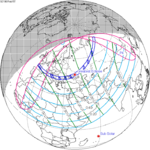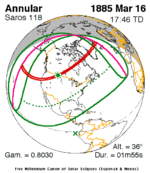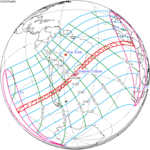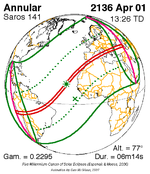
A total solar eclipse occurred at the Moon's descending node of orbit on Wednesday, June 30, 1954, with a magnitude of 1.0357. A solar eclipse occurs when the Moon passes between Earth and the Sun, thereby totally or partly obscuring the image of the Sun for a viewer on Earth. A total solar eclipse occurs when the Moon's apparent diameter is larger than the Sun's, blocking all direct sunlight, turning day into darkness. Totality occurs in a narrow path across Earth's surface, with the partial solar eclipse visible over a surrounding region thousands of kilometres wide. Occurring about 3.1 days after perigee, the Moon's apparent diameter was larger.

A total solar eclipse occurred at the Moon's ascending node of orbit between Tuesday, February 13 and Wednesday, February 14, 1934, with a magnitude of 1.0321. A solar eclipse occurs when the Moon passes between Earth and the Sun, thereby totally or partly obscuring the image of the Sun for a viewer on Earth. A total solar eclipse occurs when the Moon's apparent diameter is larger than the Sun's, blocking all direct sunlight, turning day into darkness. Totality occurs in a narrow path across Earth's surface, with the partial solar eclipse visible over a surrounding region thousands of kilometres wide. Occurring only 1.6 days after perigee, the Moon's apparent diameter was smaller.

A total solar eclipse occurred at the Moon's ascending node of orbit on Sunday, October 12, 1958, with a magnitude of 1.0608. A solar eclipse occurs when the Moon passes between Earth and the Sun, thereby totally or partly obscuring the image of the Sun for a viewer on Earth. A total solar eclipse occurs when the Moon's apparent diameter is larger than the Sun's, blocking all direct sunlight, turning day into darkness. Totality occurs in a narrow path across Earth's surface, with the partial solar eclipse visible over a surrounding region thousands of kilometres wide. Occurring about 5.5 hours before perigee, the Moon's apparent diameter was larger.

A total solar eclipse will occur at the Moon's descending node of orbit between Saturday, December 25 and Sunday, December 26, 2038, with a magnitude of 1.0268. A solar eclipse occurs when the Moon passes between Earth and the Sun, thereby totally or partly obscuring the image of the Sun for a viewer on Earth. A total solar eclipse occurs when the Moon's apparent diameter is larger than the Sun's, blocking all direct sunlight, turning day into darkness. Totality occurs in a narrow path across Earth's surface, with the partial solar eclipse visible over a surrounding region thousands of kilometres wide. Occurring about 1.7 days after perigee, the Moon's apparent diameter will be larger.

An annular solar eclipse occurred at the Moon's ascending node of orbit on Wednesday, August 22, 1979, with a magnitude of 0.9329. A solar eclipse occurs when the Moon passes between Earth and the Sun, thereby totally or partly obscuring the image of the Sun for a viewer on Earth. An annular solar eclipse occurs when the Moon's apparent diameter is smaller than the Sun's, blocking most of the Sun's light and causing the Sun to look like an annulus (ring). An annular eclipse appears as a partial eclipse over a region of the Earth thousands of kilometres wide. Occurring about 15 hours before apogee, the Moon's apparent diameter was smaller.

An annular solar eclipse occurred at the Moon's ascending node of orbit on Sunday, January 16, 1972, with a magnitude of 0.9692. A solar eclipse occurs when the Moon passes between Earth and the Sun, thereby totally or partly obscuring the image of the Sun for a viewer on Earth. An annular solar eclipse occurs when the Moon's apparent diameter is smaller than the Sun's, blocking most of the Sun's light and causing the Sun to look like an annulus (ring). An annular eclipse appears as a partial eclipse over a region of the Earth thousands of kilometres wide. Occurring about 7.3 days after apogee, the Moon's apparent diameter was smaller.

An annular solar eclipse occurred at the Moon's descending node of orbit on Friday, January 25, 1963, with a magnitude of 0.9951. A solar eclipse occurs when the Moon passes between Earth and the Sun, thereby totally or partly obscuring the image of the Sun for a viewer on Earth. An annular solar eclipse occurs when the Moon's apparent diameter is smaller than the Sun's, blocking most of the Sun's light and causing the Sun to look like an annulus (ring). An annular eclipse appears as a partial eclipse over a region of the Earth thousands of kilometres wide. The Moon's apparent diameter was near the average diameter because it occurred 8.2 days after apogee and 3.7 days before perigee.

An annular solar eclipse occurred at the Moon's ascending node of orbit on Friday, August 11, 1961, with a magnitude of 0.9375. A solar eclipse occurs when the Moon passes between Earth and the Sun, thereby totally or partly obscuring the image of the Sun for a viewer on Earth. An annular solar eclipse occurs when the Moon's apparent diameter is smaller than the Sun's, blocking most of the Sun's light and causing the Sun to look like an annulus (ring). An annular eclipse appears as a partial eclipse over a region of the Earth thousands of kilometres wide. Occurring about 7 hours after apogee, the Moon's apparent diameter was smaller.

An annular solar eclipse occurred at the Moon's descending node of orbit on Tuesday, April 30, 1957, with a magnitude of 0.9799. A solar eclipse occurs when the Moon passes between Earth and the Sun, thereby totally or partly obscuring the image of the Sun for a viewer on Earth. An annular solar eclipse occurs when the Moon's apparent diameter is smaller than the Sun's, blocking most of the Sun's light and causing the Sun to look like an annulus (ring). An annular eclipse appears as a partial eclipse over a region of the Earth thousands of kilometres wide. Occurring about 6.1 days after apogee, the Moon's apparent diameter was smaller.

An annular solar eclipse occurred at the Moon's ascending node of orbit on Tuesday, January 5, 1954, with a magnitude of 0.972. A solar eclipse occurs when the Moon passes between Earth and the Sun, thereby totally or partly obscuring the image of the Sun for a viewer on Earth. An annular solar eclipse occurs when the Moon's apparent diameter is smaller than the Sun's, blocking most of the Sun's light and causing the Sun to look like an annulus (ring). An annular eclipse appears as a partial eclipse over a region of the Earth thousands of kilometres wide. The Moon's apparent diameter was near the average diameter because it occurred 7.5 days after apogee and 5.3 days before perigee.

A total solar eclipse occurred at the Moon's descending node of orbit between Monday, September 11, 1950 and Tuesday, September 12, 1950, with a magnitude of 1.0182. A solar eclipse occurs when the Moon passes between Earth and the Sun, thereby totally or partly obscuring the image of the Sun for a viewer on Earth. A total solar eclipse occurs when the Moon's apparent diameter is larger than the Sun's, blocking all direct sunlight, turning day into darkness. Totality occurs in a narrow path across Earth's surface, with the partial solar eclipse visible over a surrounding region thousands of kilometres wide. Occurring about 3.2 days before perigee, the Moon's apparent diameter was larger.

A total solar eclipse will occur at the Moon's ascending node of orbit on Sunday, May 11, 2059, with a magnitude of 1.0242. A solar eclipse occurs when the Moon passes between Earth and the Sun, thereby totally or partly obscuring the image of the Sun for a viewer on Earth. A total solar eclipse occurs when the Moon's apparent diameter is larger than the Sun's, blocking all direct sunlight, turning day into darkness. Totality occurs in a narrow path across Earth's surface, with the partial solar eclipse visible over a surrounding region thousands of kilometres wide. Occurring about 3.5 days after perigee, the Moon's apparent diameter will be larger.

A total solar eclipse will occur at the Moon's descending node of orbit between Thursday, April 10 and Friday, April 11, 2070, with a magnitude of 1.0472. A solar eclipse occurs when the Moon passes between Earth and the Sun, thereby totally or partly obscuring the image of the Sun for a viewer on Earth. A total solar eclipse occurs when the Moon's apparent diameter is larger than the Sun's, blocking all direct sunlight, turning day into darkness. Totality occurs in a narrow path across Earth's surface, with the partial solar eclipse visible over a surrounding region thousands of kilometres wide. Occurring about 1.6 days before perigee, the Moon's apparent diameter will be larger.

A total solar eclipse will occur at the Moon's ascending node of orbit between Monday, October 3 and Tuesday, October 4, 2089, with a magnitude of 1.0333. A solar eclipse occurs when the Moon passes between Earth and the Sun, thereby totally or partly obscuring the image of the Sun for a viewer on Earth. A total solar eclipse occurs when the Moon's apparent diameter is larger than the Sun's, blocking all direct sunlight, turning day into darkness. Totality occurs in a narrow path across Earth's surface, with the partial solar eclipse visible over a surrounding region thousands of kilometres wide. Occurring about 2.3 days after perigee, the Moon's apparent diameter will be larger.

A total solar eclipse occurred at the Moon's ascending node of orbit on Thursday, October 12, 1939, with a magnitude of 1.0266. A solar eclipse occurs when the Moon passes between Earth and the Sun, thereby totally or partly obscuring the image of the Sun for a viewer on Earth. A total solar eclipse occurs when the Moon's apparent diameter is larger than the Sun's, blocking all direct sunlight, turning day into darkness. Totality occurs in a narrow path across Earth's surface, with the partial solar eclipse visible over a surrounding region thousands of kilometres wide. Occurring about 1.8 days after perigee, the Moon's apparent diameter was larger.

A total solar eclipse occurred at the Moon's ascending node of orbit on Saturday, October 1, 1921, with a magnitude of 1.0293. A solar eclipse occurs when the Moon passes between Earth and the Sun, thereby totally or partly obscuring the image of the Sun for a viewer on Earth. A total solar eclipse occurs when the Moon's apparent diameter is larger than the Sun's, blocking all direct sunlight, turning day into darkness. Totality occurs in a narrow path across Earth's surface, with the partial solar eclipse visible over a surrounding region thousands of kilometres wide. Occurring about 1.9 days after perigee, the Moon's apparent diameter was larger.

A total solar eclipse occurred at the Moon's ascending node of orbit on Tuesday, September 8, 1885, with a magnitude of 1.0332. A solar eclipse occurs when the Moon passes between Earth and the Sun, thereby totally or partly obscuring the image of the Sun for a viewer on Earth. A total solar eclipse occurs when the Moon's apparent diameter is larger than the Sun's, blocking all direct sunlight, turning day into darkness. Totality occurs in a narrow path across Earth's surface, with the partial solar eclipse visible over a surrounding region thousands of kilometres wide. Occurring about 2.3 days after perigee, the Moon's apparent diameter was larger.

A total solar eclipse occurred at the Moon's descending node of orbit on Wednesday, May 17, 1882, with a magnitude of 1.0200. A solar eclipse occurs when the Moon passes between Earth and the Sun, thereby totally or partly obscuring the image of the Sun for a viewer on Earth. A total solar eclipse occurs when the Moon's apparent diameter is larger than the Sun's, blocking all direct sunlight, turning day into darkness. Totality occurs in a narrow path across Earth's surface, with the partial solar eclipse visible over a surrounding region thousands of kilometres wide. Occurring about 4.2 days after perigee, the Moon's apparent diameter was larger.

A total solar eclipse occurred at the Moon's descending node of orbit on Wednesday, November 30, 1853, with a magnitude of 1.0485. A solar eclipse occurs when the Moon passes between Earth and the Sun, thereby totally or partly obscuring the image of the Sun for a viewer on Earth. A total solar eclipse occurs when the Moon's apparent diameter is larger than the Sun's, blocking all direct sunlight, turning day into darkness. Totality occurs in a narrow path across Earth's surface, with the partial solar eclipse visible over a surrounding region thousands of kilometres wide. Occurring about 8.5 hours before perigee, the Moon's apparent diameter was larger.

A total solar eclipse occurred at the Moon's descending node of orbit between Saturday, June 26 and Sunday, June 27, 1824, with a magnitude of 1.0578. A solar eclipse occurs when the Moon passes between Earth and the Sun, thereby totally or partly obscuring the image of the Sun for a viewer on Earth. A total solar eclipse occurs when the Moon's apparent diameter is larger than the Sun's, blocking all direct sunlight, turning day into darkness. Totality occurs in a narrow path across Earth's surface, with the partial solar eclipse visible over a surrounding region thousands of kilometres wide. Occurring about 1.9 days before perigee, the Moon's apparent diameter was larger.

























































































































